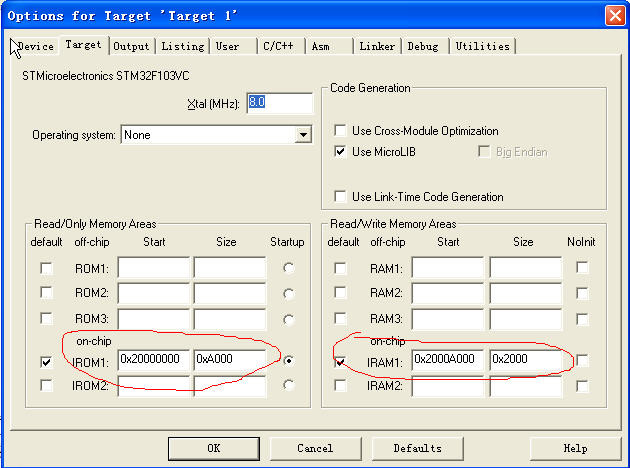The following settings are required:
1. Writing RAM.INI file
FUNC void Setup (void) {
SP = _RDWORD(0x20000000); // Setup Stack Pointer
PC = _RDWORD(0x20000004); // Setup Program Counter
_WDWORD(0xE000ED08, 0x20000000); // Setup Vector Table Offset Register
}
LOAD .\output\release.axf INCREMENTAL // Download,.axf
Setup(); // Setup for Running
g, main
2. Reset NVIC in the main function as follows:
#ifdef VECT_TAB_RAM
/* Set the Vector Table base location at 0x20000000 */
NVIC_SetVectorTable(NVIC_VectTab_RAM+0x2000, 0x0);
#else /* VECT_TAB_FLASH */
/* Set the Vector Table base location at 0x08000000 */
NVIC_SetVectorTable(NVIC_VectTab_RAM, 0x0); // NVIC_VectTab_FLASH
#endif
3. Click OPTION->DEBUG option SETTING -> FLASH DOWNLOAD and then REMOVE FLASH.
4. Define RAM_MODE, REMAP in OPTION-》ASM in the startup file
5. Select ULINK1 Cortex Debugger in the Debug tab (the software uses the crack method of brother yjgyiysbcc). Unselect Load Application at Start and add the startup script RAM.ini in Initialization.
6. Set the program download address in the TARGET option. As shown in the figure below, the address of IROM1 points to the RAM space of STM32. How to allocate the space depends on your needs. The internal RAM size of this processor is 20K, 16K is allocated to the read-only area, and 4K is allocated to the readable and writable area. In this way, the size of IROM is set to 0x4000, the start of IRAM1 becomes 0X20004000, and the size is only 0X1000.
7. Uncheck UPDATE TARGET BEFORE DEBUGING in the UTILITES option

Previous article:STM32 external crystal oscillator provides common system clock settings after frequency multiplication
Next article:stm32f1 clock analysis
- Popular Resources
- Popular amplifiers
 Professor at Beihang University, dedicated to promoting microcontrollers and embedded systems for over 20 years.
Professor at Beihang University, dedicated to promoting microcontrollers and embedded systems for over 20 years.
- Innolux's intelligent steer-by-wire solution makes cars smarter and safer
- 8051 MCU - Parity Check
- How to efficiently balance the sensitivity of tactile sensing interfaces
- What should I do if the servo motor shakes? What causes the servo motor to shake quickly?
- 【Brushless Motor】Analysis of three-phase BLDC motor and sharing of two popular development boards
- Midea Industrial Technology's subsidiaries Clou Electronics and Hekang New Energy jointly appeared at the Munich Battery Energy Storage Exhibition and Solar Energy Exhibition
- Guoxin Sichen | Application of ferroelectric memory PB85RS2MC in power battery management, with a capacity of 2M
- Analysis of common faults of frequency converter
- In a head-on competition with Qualcomm, what kind of cockpit products has Intel come up with?
- Dalian Rongke's all-vanadium liquid flow battery energy storage equipment industrialization project has entered the sprint stage before production
- Allegro MicroSystems Introduces Advanced Magnetic and Inductive Position Sensing Solutions at Electronica 2024
- Car key in the left hand, liveness detection radar in the right hand, UWB is imperative for cars!
- After a decade of rapid development, domestic CIS has entered the market
- Aegis Dagger Battery + Thor EM-i Super Hybrid, Geely New Energy has thrown out two "king bombs"
- A brief discussion on functional safety - fault, error, and failure
- In the smart car 2.0 cycle, these core industry chains are facing major opportunities!
- The United States and Japan are developing new batteries. CATL faces challenges? How should China's new energy battery industry respond?
- Murata launches high-precision 6-axis inertial sensor for automobiles
- Ford patents pre-charge alarm to help save costs and respond to emergencies
- New real-time microcontroller system from Texas Instruments enables smarter processing in automotive and industrial applications
- The clock configured by STM32CubeMX is inaccurate?
- Get a 2,000 yuan ticket for free! Exclusive benefits for EEWorld netizens
- About GRBL host computer transmission protocol
- MicroPython now supports Ethernet peripherals on ST development boards
- Double gift for appointment viewing: In-depth analysis of network analyzer calibration basics and professional tips
- When RS485 bus communication is idle, the differential voltage on the line increases as the number of terminal devices increases.
- Newbie help
- Initial understanding of R329 development board - hardware
- [NXP Rapid IoT Review] NO.2 Online IDE-----Easy to use, easy programming
- 【XMC4800 Relax EtherCAT Kit Review】+ Getting Started with DAVE, WINUSB APP Application Experience

 usb_host_device_code
usb_host_device_code Transplantation of real-time operating system RT-ThreadSmart on STM32MP1
Transplantation of real-time operating system RT-ThreadSmart on STM32MP1
















 京公网安备 11010802033920号
京公网安备 11010802033920号